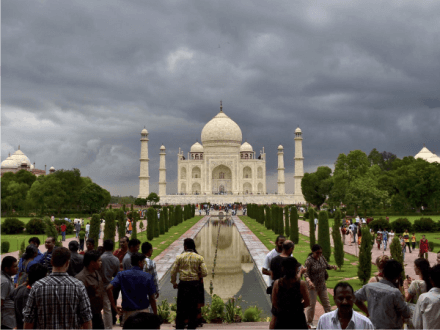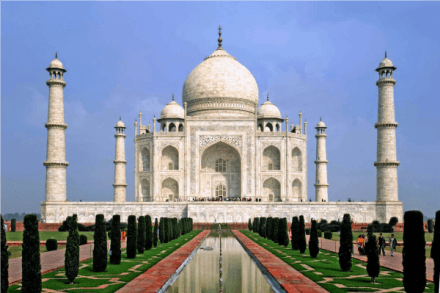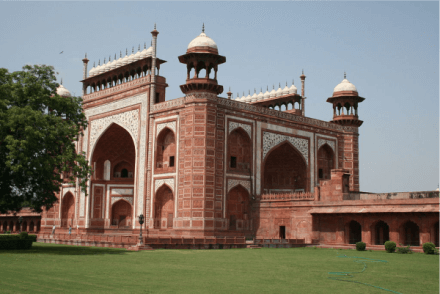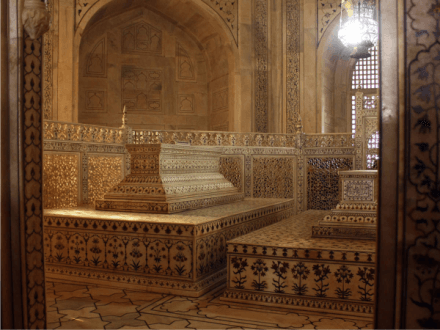My Favourite Place EssayEveryone on the planet has a favourite place where they sense belongingness and feel peaceful while being unhappy or stressed. It becomes a place to go to when we get hurt. These places make us forget our problems and think of happy and beautiful memories. We love to sit there and feel relieved from all our problems. It serves as an environment to change our moods. In India, numerous stunning historical sites are worth exploring. The most gorgeous of all, undoubtedly, is the Taj Mahal in Agra which is my favourite place. I went there together with my family. It is a marbleized daydream. The sight had a psychological influence on me. It stood out with immense beauty and charisma. The surfaces appeared to be white. Its tremendous splendour was decorated by beautiful grassy tufts and Cyprus tree buds. The structure's ground appeared much more magnificent because of its gorgeous nature. 
Taj Mahal - A Symbol of Love and BeautyThe Taj Mahal is one of India's most magnificent and fascinating historical monuments. Shah Jahan, the ruler of India, built it as a historical memorial in honor of his late wife, Mumtaz. It is located in a sizable environment with a lake, grass, and plenty of vegetation on the front and sides, a garden, and a river at the back. Taj Mahal is situated in the Indian state of Uttar Pradesh, in Agra. It is one of the seven wonders of the world. The structure is constructed of white marble and is the most attractive. It resembles a dream-like paradise, has a beautiful pattern, and is embellished with majestic gorgeousness. One of historical nature's incredible creations, it is a wonder of the world. Under the dome, in a shadowy room, lie the tombs of the king and the queen. On the walls are numerous Quranic rhymes that were created using tiny pieces of various colored glasses. It features four beautifully placed minarets at each of its four edges. The majestic Taj Mahal structure is more than 350 years old. Shah Jahan, the fifth Mughal ruler of India, constructed it during the 17th century. The Taj Mahal's romantic odor is still present all the time. It is comparable to a diamond in the Mughal architectural throne. Shah Jhah's favourite partner, Mumtaz Mahal, was Shah Jhah's favourite; she often accompanied him on military operations, and during one such mission in Burhanpur, she passed away while giving birth. The deceased queen was carried to Agra and cremated near the Yamuna River. After a few days of our trip to the Taj Mahal, there was a whole moon night. We went to the Taj that night again. In the silvery moonlight, it sparkled with splendor. My excitement knew no boundaries when I noticed its image in the Yamuna River. It was possible to see a crisp picture of marble. I closed my eyes and reopened them repeatedly to confirm that it was true. It wasn't a dream. God provides the wonders of nature, while man's hand provides magnificent works of art and architecture. How was it possible for men to create art with such a conscience? Even now, I can wonder, and if I choose, I can continue to visualize the Taj's beauty. What incredible beauty a man can create! Saying that the Taj is a dream in marble is not inaccurate. It has a rare charm that casts its magic spell on visitors both from India and abroad, who would never have thought that a fanciful thought of a love-lorn emperor would become a world-famous monument. The Taj has become synonymous with India and the Mughals. It is a much-awaited visit to Agra and the Taj that every couple, young and old, looks forward to. Its majesty and beauty are enhanced by the peaceful Yamuna that runs by its side. As probably no other guest who has experienced love can, I will never forget this journey. The Mughal Emperor Shahjahan constructed the Taj Mahal nearly three hundred years ago in honor of his adored queen, Mumtaj Mahal. The Taj Mahal is referred to as "the dream of marble" by the great Rabindranath Tagore. The greenery surrounding the monument, which is situated on the Yamuna River's banks, heightens the freshness of the air. The lovely moonlight that rises at night brightens the view of the structure. 
Construction of Taj MahalMarble was used for the construction of the Taj Mahal. This stone was immediately imported from several nations throughout the world. They started building it in 1630, and it took them about 20 years to finish. Shah Jahan turned down several ideas before deciding on the Taj Mahal's existing designs. The monument's walls have very rare stones carved on them. Skillful architecture is used extensively in the Taj Mahal. The four pillars that support the outer edges are slightly slanted. This has been accomplished to protect the monument from any type of natural disaster. The Taj Mahal was built at a significant financial cost to Shah Jahan. The Taj Mahal's architecture exhibits exact bilateral symmetry. The Taj is nearly as wide as it is tall, with the mausoleum (rauza) and its four minarets as the focal point and a mosque and meeting hall (Mehman Khana) on either side (55m). The finely carved pietra dura with semiprecious gemstone inlay is among the structure's highlights. In line with Shah Jahan's intention that the tomb and garden should symbolize heaven on earth, the color of the crystalline marble continuously changes from daylight to dusk and lends it a mystical air. It is a marvel of the globe and a rare example of human creation from the illustrious Mughal period. We can also observe that it took about 20,000 employees to finish the construction of this monument. Additionally, several architectural styles, including Indian, Turkish, Persian, and more, were used as models for the Taj Mahal's design. The marble screens and walls, which were created using a fantastic assortment of semiprecious stones, required the expertise of master masons, artisans, designers, and calligraphers who were called upon from Persia, the Ottoman Empire, and even Europe. In 1653, the complex was finished. Sadly, the Emperor was deposed by his son when it was completed, and he spent the remainder of his life behind bars in prison with a window facing his masterpiece. Shah Jahan passed away in 1666 and was cremated at the Taj Mahal with his wife. In addition, there is a stunning fountain with streams situated in front of the Taj Mahal. A fascinating scene is created by the Taj Mahal's reflection in the lake. It seemed to be no less than a fairyland. Finally, the Taj Mahal's grandeur and tradition are something of which every Indian is proud. Every country around the globe is aware of such a masterpiece. Every year, between 2 and 4 million tourists visit the Taj Mahal. The monument's beauty and significance draw the greatest attention and give it global fame. Interior of the Taj MahalThe Taj Mahal's architecture is highlighted by a vast octagonal center room, from which eight lesser chambers radiate. There are 16 such nooks in all since the smaller rooms are distributed over two floors. Mumtaz Mahal and Shah Jahan's cenotaphs are situated in the main funeral hall, which is located in the center. The two elaborate marble cenotaphs, which face the south, are encircled by a marble wall. The sarcophagi themselves are kept in a relatively simple crypt underneath the tomb. Shah Jahan glamorously disregarded the Islamic prohibition on excessive tomb adornment and ordered extensive embellishment of the inner surface. The flooring and art designs on the walls and floors are embellished with pietra dura and lapidary inlays. Numerous colorful stones and jewels in abundance were employed in the design. Marble latticework in the windows and arches filters light, which is reflected off of highly polished surfaces. 
Other Buildings in The Taj MahalEvery component of the Taj Mahal was created to preserve its splendor and grandeur. The main entrance archway, known as Darwaza-e-Rauza, is made of red sandstone and is built such that, from the outside, it is impossible to view the Taj Mahal, but as someone enters, they are greeted with its beautiful appearance. Red sandstone was used in constructing the Taj Mahal's masjid on the western end and the Nakkar Khana, or guest room, on the eastern end. They are designed as mirror reflections of one another or jawab in Mughal architectural jargon, and they emphasize the transparent splendor of the white marble building while enhancing the Taj's elegance. Later DaysShah Jahan was overthrown by his son Aurangzeb shortly after the Taj Mahal was finished and placed under house arrest near Agra Fort. Aurangzeb cremated Shah Jahan next to his wife after his passing. The Jat kings of Bharatpur stormed Agra and destroyed the Taj Mahal in the 18th century. They removed the gold and silver walls and the two lamps, one made of gemstones and the other of silver, that were suspended over the main monument. Mughal writer Kanbo claimed that the Jat despoliation also involved the removal of the gold cover that coated the 4.6-meter-tall (15-foot) finial at the top of the central dome. The structure's components were in poor condition by the late 19th century. A significant repair effort was commissioned by British viceroy Lord Curzon at the end of the nineteenth century, and it was finished in 1908. Lord Curzon commissioned the massive light inside the room after he found the design in a masjid in Cairo. European-style grasses were added to the yard during this period, and they are still there today. 
SymbolismThe Taj Mahal has gained widespread recognition due to the millions of tourists it draws and the press coverage it has earned, and, as a result, it has come to represent India. The Taj Mahal is not only a well-known representation of love but also symbolizes Shah Jahan's riches, strength, and the truth that the kingdom flourished during his leadership. Shah Jahan adopted this idea when building the Taj Mahal. Bilateral symmetry with a central axis has historically been used by kings as a sign of a governing power that gives stability and peace. The corners of the Taj Mahal have been designed so that if viewed from the centre, the sun may be seen rising and sinking on the north and south edges of the summer and winter solstices, respectively. The design is also oriented in the conventional north-south direction. The Taj now serves as a symbolic horizon. The Taj Mahal's design and layout represent Mumtaz Mahal's palace in the Garden of Paradise, from the monument to the lawns and even beyond. The notion of the Gardens of Paradise is developed into the architecture of the tomb as well. The inside is decorated with vibrant vines and flowers that are covered in semi-precious rocks, employing a method known as pietra dura, or Parchin Kari, as the Mughals termed it. According to the condition of the day and the weather, the structure seems to have a minor color shift. Through the reflecting pools and the surface of the structure itself, the sky has been incorporated into the layout, in addition to certain other ways. This is a different technique to convey that Allah is at the location. Ebba Koch, an art expert and leading authority on comprehending and interpreting Mughal architecture and the Taj Mahal, claims that the layout of the Taj's complete structure represents both lives on this earth and eternity, which is a part of the divine's symbolism. The design has been divided into two parts: the white marble monument and the lawns make up one-half, while the red sandstone site is intended for global markets. The white tomb symbolizes Mumtaz's wisdom, devotion, and trust. Eleanor Roosevelt, a seasoned traveler, claimed that the color white represented the sanctity of pure love. According to Koch's interpretation, the magnificent gate in the center symbolizes the passage between the two different worlds, and the materialistic side's design is a mirror copy of the heavenly side, symbolizing Islamic beliefs. It is believed that Mumtaz Mahal herself is represented by the Taj, which is also considered a feminine structural shape. ConclusionThe Taj Mahal is one of the nation's most beautiful creations. It is listed among the seven world marvels. People from different nations, not just Indians, are charmed by its uniqueness. Respect for the craftsmanship and architecture of ancient India will also be cherished for as long as this magnificent structure remains in this nation. Even decades after its completion, the Taj Mahal retains its majesty and remains the most appealing tourist attraction ever created by humans. The Darwaza, or main entrance; the Bageecha, or gardens; the Masjid, or mosque; the Naqqar Khana, or rest house; and the Rauza, or central tomb, are the Taj Mahal's five principal structural elements. So on my trip to my favourite place, the Taj Mahal, we had a great time and learned about the natural beauty of our country. We all admired its majesty and attractiveness, and it made us feel good. We intend to go back there frequently. FAQs1. What is your favourite place you have ever visited? I found the Taj Mahal the most beautiful place I have ever visited. Eventually, the Taj Mahal became my favourite place. 2. Where is the place located? The Taj Mahal is located in Agra in Uttar Pradesh in India. 3. What kind of vibes do you get at your favourite place? Whenever I visit the place, I always remember the beautiful memories of my life. I feel happy, joyful, confident, peaceful and positive. 4. Why is the place so special to you? It possesses exceptional aesthetic features in balance, symmetry, and the harmonic mixing of numerous parts, making it a masterpiece of architectural style in design, treatment, and construction. 5. How many times have you visited the place? I have visited over Taj Mahal about six times with my friends. 6. How much time do you spend in your favourite place? I spend four hours viewing the place, and after that, I sit for two hours for peace of mind and watch the beauty of the Taj Mahal. 7. Whose company do you wish to have in your favourite place? I always love to have visited the place with my friends. We enjoy ourselves a lot together with jokes and music. 8. Who is the creator of your favourite place? Shah Jahan built the Taj Mahal in 1631 in memory of his deceased wife, Mumtaz Mahal. 9. When does your favourite place look most beautiful? Early summer, i.e., from March to June at sunrise or sunset, is the best time to visit the Taj Mahal.
Next TopicMy Role Model Essay
|
 For Videos Join Our Youtube Channel: Join Now
For Videos Join Our Youtube Channel: Join Now
Feedback
- Send your Feedback to [email protected]
Help Others, Please Share









